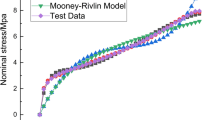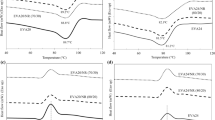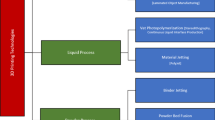Abstract
Fused filament fabrication (FFF) has become one of the most popular, practical, and low-cost additive manufacturing techniques for fabricating geometrically complex thermoplastic polyurethane (TPU) elastomer. However, there are still some uncertainties concerning the relationship between several operating parameters applied in this technique and the mechanical properties of the processed material. In this research, the influences of extruder temperature and raster orientation on the mechanical properties of the FFF-processed TPU elastomer were studied. A series of uniaxial tensile tests was carried out to determine tensile strength, strain, and elastic modulus of TPU elastomer that had been printed with various extruder temperatures, i.e., 190–230 °C, and raster angles, i.e., 0–90°. Thermal and chemical characterizations were also conducted to support the analysis in this research. The results showed the ductile and elastic characteristics of the FFF-processed TPU, with specific tensile strength and strain that could reach up to 39 MPa and 600%, respectively. The failure mechanisms operating on the FFF-processed TPU and the result of stress analysis by using the developed Mohr’s circle are also discussed in this paper. In conclusion, the extrusion temperature of 200 °C and raster angle of 0° could be preferred to be applied in the FFF process to achieve high strength and ductile TPU elastomer.











Similar content being viewed by others
References
Dizon JRC, Espera AH, Chen Q, Advincula RC (2018) Mechanical characterization of 3D-printed polymers. Addit Manuf. 20:44–67. https://doi.org/10.1016/j.addma.2017.12.002
Huang SH, Liu P, Mokasdar A, Hou L (2013) Additive manufacturing and its societal impact: a literature review. Int J Adv Manuf Technol 67:1191–1203. https://doi.org/10.1007/s00170-012-4558-5
Stansbury JW, Idacavage MJ (2016) 3D printing with polymers: challenges among expanding options and opportunities. Dent Mater 32:54–64. https://doi.org/10.1016/j.dental.2015.09.018
Lee Ventola C (2014) Medical applications for 3D printing: current and projected uses. Pharm Thearpeutics 39:704–711 https://www.ncbi.nlm.nih.gov/pmc/articles/PMC4189697/
Bogue R (2013) 3D printing: the dawn of a new era in manufacturing? Assem Autom 33:307–311. https://doi.org/10.1108/AA-06-2013-055
Choonara YE, Du Toit LC, Kumar P, Kondiah PPD, Pillay V (2016) 3D-printing and the effect on medical costs: a new era? Exp Rev Pharmacoecon Outcomes Res 16:23–32. https://doi.org/10.1586/14737167.2016.1138860
Liu A, Xue GH, Sun M, Shao HF, Ma CY, Gao Q, Gou ZR, Yan SG, Liu YM, He Y (2016) 3D printing surgical implants at the clinic: a experimental study on anterior cruciate ligament reconstruction. Sci Rep 6:1–13. https://doi.org/10.1038/srep21704
Tan LJ, Zhu W, Zhou K (2020) Recent progress on polymer materials for additive manufacturing. Adv Funct Mater 30:2003062. https://doi.org/10.1002/adfm.202003062
Tanikella NG, Wittbrodt B, Pearce JM (2017) Tensile strength of commercial polymer materials for fused filament fabrication 3D printing. Addit Manuf 15:40–47. https://doi.org/10.1016/j.addma.2017.03.005
Verstraete G, Samaro A, Grymonpré W, Vanhoorne V, Van Snick B, Boone MN, Hellemans T, Van Hoorebeke L, Remon JP, Vervaet C (2018) 3D printing of high drug loaded dosage forms using thermoplastic polyurethanes. Int J Pharm 536:318–325. https://doi.org/10.1016/j.ijpharm.2017.12.002
Jung SY, Lee SJ, Kim HY, Park HS, Wang Z, Kim HJ, Yoo JJ, Chung SM, Kim HS (2016) 3D printed polyurethane prosthesis for partial tracheal reconstruction: a pilot animal study. Biofabrication. 8:045015. https://doi.org/10.1088/1758-5090/8/4/045015
Shie MY, Chang WC, Wei LJ, Huang YH, Chen CH, Shih CT, Chen YW, Shen YF (2017) 3D printing of cytocompatible water-based light-cured polyurethane with hyaluronic acid for cartilage tissue engineering applications. Materials. 10:136–149. https://doi.org/10.3390/ma10020136
Bähr F, Westkämper E (2018) Correlations between influencing parameters and quality properties of components produced by fused deposition modeling. Proc CIRP 72:1214–1219. https://doi.org/10.1016/j.procir.2018.03.048
Kallel AC, Koutiri I, Babaeitorkamani E, Khavandi A, Tamizivar M, Shirinbayar M, Tcharkhtchi A (2019) Study of bonding formation between the filaments of PLA in FFF process. Int Polym Process 34:434–444. https://doi.org/10.3139/217.3718
Behzadnasab M, Yousefi AA, Ebrahimibagha D, Nasiri F (2019) Effects of processing conditions on mechanical properties of PLA printed parts. Rapid Prototyp J 26:381–389. https://doi.org/10.1108/RPJ-02-2019-0048
Wittbrodt B, Pearce JM (2015) The effects of PLA color on material properties of 3-D printed components. Addit Manuf. 8:110–116. https://doi.org/10.1016/j.addma.2015.09.006
Abbott AC, Tandon GP, Bradford RL, Koerner H, Baur JW (2018) Process-structure-property effects on ABS bond strength in fused filament fabrication. Addit Manuf 19:29–38. https://doi.org/10.1016/j.addma.2017.11.002
Wolszczak P, Lygas K, Paszko M, Wach RA (2018) Heat distribution in material during fused deposition modelling. Rapid Prototyp J 24:615–622. https://doi.org/10.1108/RPJ-04-2017-0062
Song Y, Li Y, Song W, Yee K, Lee KY, Tagarielli VL (2017) Measurements of the mechanical response of unidirectional 3D-printed PLA. Mater Des 123:154–164. https://doi.org/10.1016/j.matdes.2017.03.051
Santana L, Ahrens CH, Da Costa Sabino Netto A, Bonin C (2017) Evaluating the deposition quality of parts produced by an open-source 3D printer. Rapid Prototyp J 23:796–803. https://doi.org/10.1108/RPJ-05-2016-0078
Ouhsti M, El Haddadi B, Belhouideg S (2018) Effect of printing parameters on the mechanical properties of parts fabricated with open-source 3D printers in PLA by fused deposition modeling. Mech Mech Eng 22:895–907. https://doi.org/10.2478/mme-2018-0070
Durgun I, Ertan R (2014) Experimental investigation of FDM process for improvement of mechanical properties and production cost. Rapid Prototyp J 20:228–235. https://doi.org/10.1108/RPJ-10-2012-0091
Rajpurohit SR, Dave HK (2018) Effect of process parameters on tensile strength of FDM printed PLA part. Rapid Prototyp J 24:1317–1324. https://doi.org/10.1108/RPJ-06-2017-0134
Ziemian S, Okwara M, Ziemian CW (2015) Tensile and fatigue behavior of layered acrylonitrile butadiene styrene. Rapid Prototyp J 21:270–278. https://doi.org/10.1108/RPJ-09-2013-0086
Es-Said OS, Foyos J, Noorani R, Mendelson M, Marloth R, Pregger BA (2000) Effect of layer orientation on mechanical properties of rapid prototyped samples. Mater Manuf Process 15:107–122. https://doi.org/10.1080/10426910008912976
**ao J, Gao Y (2017) The manufacture of 3D printing of medical grade TPU. Prog Addit Manuf 2:117–123. https://doi.org/10.1007/s40964-017-0023-1
Hohimer C, Christ J, Aliheidari N, Mo C, Ameli A (2017) 3D printed thermoplastic polyurethane with isotropic material properties. In: Behavior and Mechanics of Multifunctional Materials and Composites 2017: Proceedings Vol 10165. https://doi.org/10.1117/12.2259810
Yuan S, Bai J, Chua CK, Zhou K, Wei J (2016) Characterization of cree** and shape memory effect in laser sintered thermoplastic polyurethane. J Comput Inf Sci Eng 16:3–7. https://doi.org/10.1115/1.4034032
Yang C, Tian X, Li D, Cao Y, Zhao F, Shi C (2017) Influence of thermal processing conditions in 3D printing on the crystallinity and mechanical properties of PEEK material. J Mater Process Technol 248:1–7. https://doi.org/10.1016/j.jmatprotec.2017.04.027
Hibbeler RC (2001) Mechanics of materials, Sixth edn. Prentice-Hall, Singapore
Code availability
Not applicable.
Funding
This work was performed as part of the first author’s project funded by the Department of Mechanical and Industrial Engineering, Faculty of Engineering, Universitas Gadjah Mada, with a research grant No. 417/UN1.FTK/SK/HK/2020.
Author information
Authors and Affiliations
Contributions
• Dr. Budi Arifvianto is the project leader and responsible for the writing of this manuscript.
• Mr. Teguh Nur Iman is responsible for the data acquisition.
• Dr. Benidiktus Tulung Prayoga, Dr. Rini Dharmastiti, Dr. Urip Agus Salim, and Dr. Muslim Mahardika provide technical guidelines for the experiment and give insights related to the applications of the polymeric material used in this research.
• Dr. Suyitno is the supervisor of this project.
Corresponding author
Ethics declarations
Ethics approval
Not applicable.
Consent to participate
Not applicable.
Consent for publication
Not applicable.
Conflict of interest
The authors declare no competing interests.
Additional information
Publisher’s note
Springer Nature remains neutral with regard to jurisdictional claims in published maps and institutional affiliations.
Rights and permissions
About this article
Cite this article
Arifvianto, B., Iman, T.N., Prayoga, B.T. et al. Tensile properties of the FFF-processed thermoplastic polyurethane (TPU) elastomer. Int J Adv Manuf Technol 117, 1709–1719 (2021). https://doi.org/10.1007/s00170-021-07712-0
Received:
Accepted:
Published:
Issue Date:
DOI: https://doi.org/10.1007/s00170-021-07712-0




